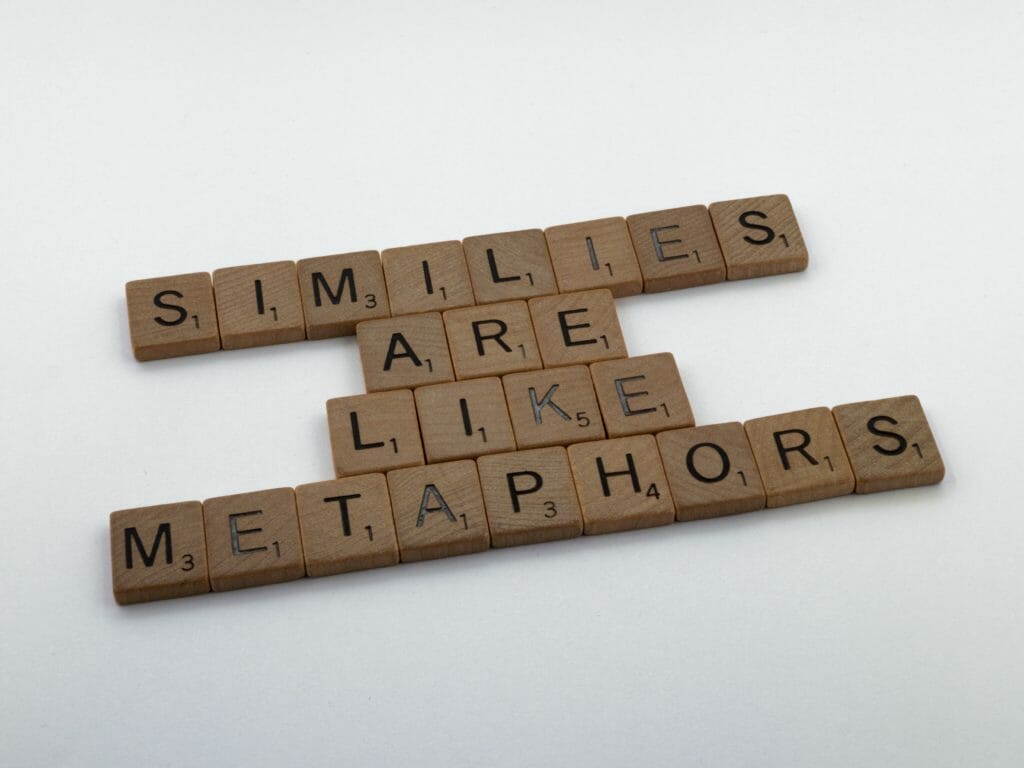Metaphor is one of the most powerful vehicles for meaning we have in storytelling and fiction writing. So many of our human experiences escape us when we try to describe them literally–who among us, without using metaphor, can really convey what it feels like to fall in love?
You can say that your heart sped up, or that you feel flustered, but none of that really gets at the truth. It’s more that you’re flying, that you’re invincible, that your love is the sun and you’re in their orbit forever.
When we’re trying to describe intense experiences, metaphor lets us do a better job by giving our audience a reference point for those experiences. Figurative language allows us to express fully through that experience, while extended metaphors act as a trusted tool of choice. When it comes to writing a good novel, this step is crucial.
If I tell you that my day was bad, that’s one thing. If I tell you my day was a nightmarish death march, that’s a little more vivid, and does a better job getting at the intensity of my emotion.
Extended metaphor, likewise, can play a huge role in getting big emotions and themes across to your reader. In this article, we’ll talk about what extended metaphor is, give you some examples, and break down how you can use it in your own work!
Table of Contents
What is an Extended Metaphor?
An extended metaphor is when we take that comparison and we stretch it out over several stanzas, paragraphs, chapters, or lines. We’re using that metaphor as a vehicle to make a larger point and really explore the assorted meanings of that comparison.
Okay, so, quick recap so we avoid confusion between these literary devices:
Simile is the comparison of two things using ‘like’ or ‘as.’ If I say my day was “as bad as a category five hurricane,” that’s a simile.
Metaphor is the comparison of two things without using like or as–you’re stating it plainly. With that hurricane example, it would be “my day was a category five hurricane.”

Tenor and Vehicle
The two fundamental parts of any metaphor are tenor and vehicle. The tenor is the thing being described, and the vehicle is the thing to which we compare the tenor.
Litcharts.com uses Life is a Highway as a brilliant example:
“In the metaphor ‘Life is a highway,’ life is the tenor because it’s the thing being described, while “highway” is the vehicle because it’s the thing life is being compared to. The metaphor operates by borrowing key attributes from the vehicle and attributing them to the tenor. The “Life is a highway” metaphor takes the attributes of a highway—including its association with journeys, adventures, speed, and the fact that we all travel them side-by-side—and connects them to life.”
Let’s use another quick example:
In Emily Dickinson’s poem “Hope is the Thing With Feathers,” she compares hope to, you guessed it, a bird. Here, the tenor is “hope,” while “the thing with feathers” is the vehicle, since it’s what we’re using to explain hope.
Allegory vs. Conceit
It’s also important to keep in mind two key types of metaphor: allegory and conceit. Knowing which you’re working with can help you use each more effectively in your own work.
Allegory contains two stories in one. You’ve got the literal events of the text, and you’ve got the second symbolic meaning. In an allegory, the author is using character, events, and plot to make a commentary on a second meaning which the reader is meant to understand on their own.
Allegory often uses a literal story which has nothing or little to do with modern reality or real-world events to tell a second story that comments on real-world events. You might get a story that, on the surface, looks like it’s about a dad taking his kid to a baseball game, but if you look closer, it’s actually about the complexities of growing up.
Conceit is the comparison between two unlike things. This is a sort of simile and metaphor combo, where we get two things that really don’t seem alike at all made comparable by the author.
For an example of conceit, if I said “Marriage is a shattered guitar,” I’d have a little explaining to do to make my case–it’s not obvious from the start, like “life is a highway.”
Extended Metaphor Examples
Still a little foggy? Let’s go over some examples from books, poetry, music, and film to give you a better idea of how extended metaphor looks in the wild.
1. The Fault in Our Stars by John Green
The Fault in Our Stars gave us that famous quote: “You put the killing thing right between your teeth, but you don’t give it the power to do its killing.” It absolutely rocked my world in 2014, and it’s still a great example of extended metaphor!
This line is said by Augustus Waters, a kid dealing with cancer. He’s explaining why he likes to carry around unlit cigarettes, but his explanation also applies to the situation he’s found himself in with Hazel Grace.
Because they’re living with chronic illness, which they understand to probably be terminal, this is how their lives feel. They have to face the reality of their situation every day without being overcome by it, and without it preventing their ability to still have a fruitful, meaningful life in the interim.
2. Angel of Small Death and the Codeine Scene by Hozier
A personal favorite of mine, this song compares a lover to an angel of small death and the codeine scene. What does that mean?
Well, ‘small death’ comes from la petite mort,’ which is a French phrase used to talk about sex. ‘The codeine scene’ obviously refers to drugs. Hozier uses this comparison to say his lover is the angel, or God, of sex and drugs. Which is pretty cool!
He pulls this metaphor into his verses to expand on the metaphor. Lines like “feeling more human and hooked on her flesh” point to this idea that he is hooked on his lover. He’s using the comparison to describe an addictive, intense attraction, and one that maybe isn’t totally healthy.
3. A Bug’s Life
Y’all remember a Bug’s Life? It’s about a group of bugs forced to perform labor for the evil grasshoppers. In the film, the bugs have to overexert themselves to feed the grasshoppers in exchange for a small amount of the product they’ve foraged. It’s an unfair system that keeps the ants hungry and scared, and the grasshoppers fed and happy.
It’s a kid’s movie, but it’s also kind of about Marxism!
In the end, the bugs are fighting to have full rights to their own labor. Why should they work so hard to see so little of the product? Why should the grasshoppers get to benefit from the bugs’ labor? The bugs want the means of production!
Remember what we said about allegory? It’s a story about bugs fighting grasshoppers, sure. But it’s also a story about workers collectivizing to overthrow an evil corporation.
Tips for Writing an Extended Metaphor
Now that we know what an extended metaphor is, I’ve got a few tips and tricks for how to make sure your metaphors land perfectly!
1. Know What You’re Working With
Early on, identify your tenor and vehicle. Know what the thing you’re comparing is, and know what you’re comparing it to. This can help avoid reckless or offensive comparisons, and it’ll help you keep your symbolism and imagery relevant and fresh.
If you’re not sure what you want to use as your vehicle, that’s okay! Identify your tenor and write it down. Then, take a minute to write about what that’s like. Once you’ve identified something you can draw parallels to, take another moment to write about why those things are similar.
Writing out the metaphor will help you know where it’s going. There are many ways to start a story, and outlining your story can help you keep it focused and streamlined. Having a grasp on your metaphor early on can help you keep it consistent.
2. Keep it Subtle
No one likes a heavy-handed metaphor. If you’re using an extended metaphor, try to give your audience exactly enough to get the parallel you’re making and nothing more. Like with everything you write, it’s way more impactful if the reader puts it together themselves, and this is especially true for metaphor!
Remember how we talked about metaphor being a great vehicle for conveying things we could otherwise get across?
If you use a metaphor that’s too easy–something sweet being sugar, for example–you’re missing out, because we’re not actually learning anything new or interesting. We already know sugar is sweet.
3. Avoid Clichés
This ties in with the last point, but cliche is perhaps the biggest pitfall to metaphor for new writers. It takes a little bit to hone a new, interesting metaphor, but it’s very important. Like we mentioned in the last section, you want to use your metaphor to make an interesting point, and cliche metaphors have nothing new to offer your reader.
They can also come across as lazy, cheesy, or trite, which might ruin the overall effect of your scene.
Not sure whether your metaphor has been done before? Do a quick google search and make sure you read widely to get a sense of what’s been done.
Everything has already been done, of course, but you just want to make sure you’re not regurgitating something about your love being a beautiful flower. Or if your love is a beautiful flower, you want to make an interesting, unique point about it.
There’s a simple trick I like to use to avoid metaphor that’s too on-the-nose. When I’ve got a comparison I want to make, I do what we discussed earlier and write it down. Generally, though, I like to disregard the first couple things I come up with. The first things that come to mind are usually the things I’ve seen before, or what I remember from pop culture. The stuff that comes up when I dig deeper is usually more unique.
Need a little help? Our fiction coach created this amazing training for creative writers and fiction writers! Check it out!
What’s your favorite allegorical novel? Got any favorite extended metaphors from poems or stories? Let us know in the comments!
